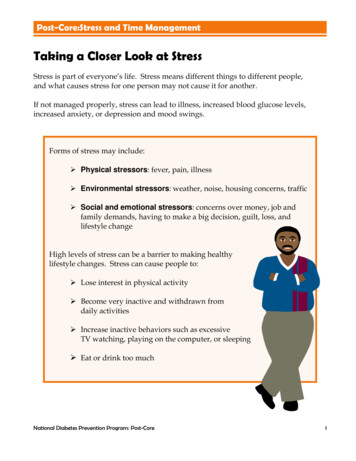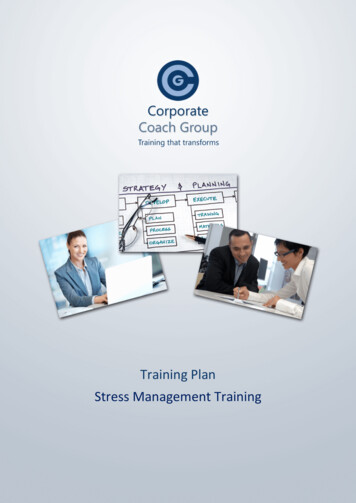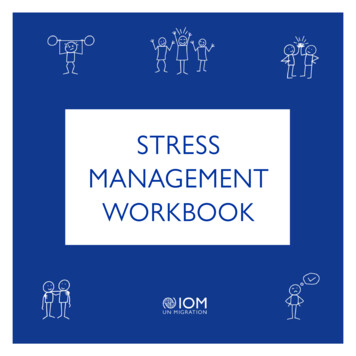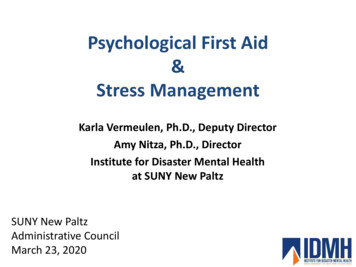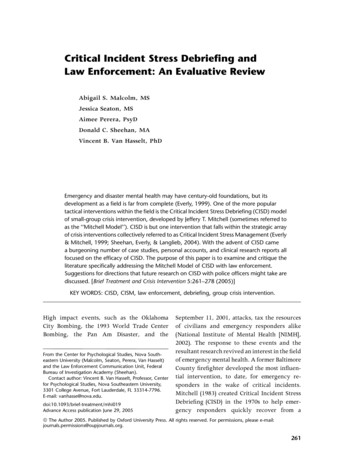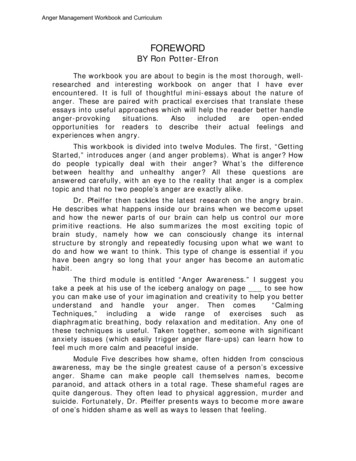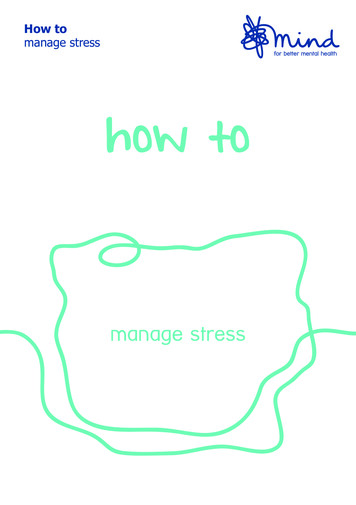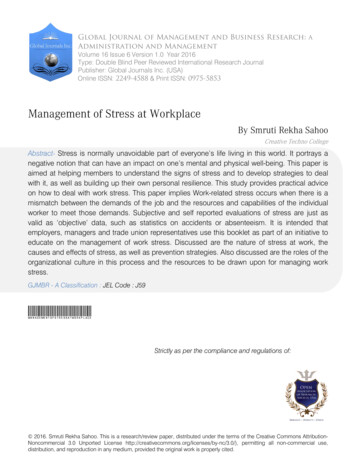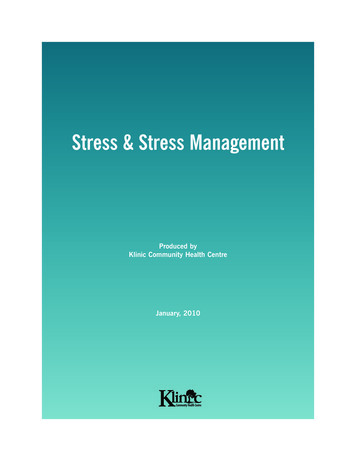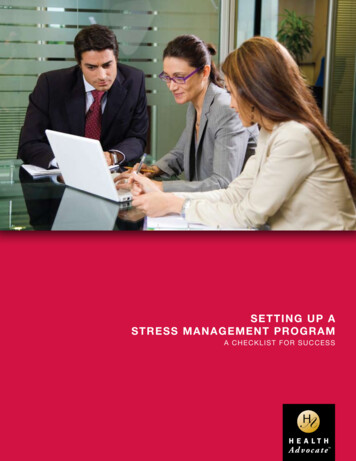
Transcription
s e t t i n g up as t r e s s ma na g e me nt p r ogr amA CHECKLIST F OR s u ccess
About this checklistThis publication provides a step-by-step guide to initiate a business strategy to help employees bettermanage stress and reduce healthcare costs. No matter if your investment is relatively simple or moresubstantial, the key to success is to have long-range strategies customized to your employee populationand that include both organizational and individual approaches. Following these strategies can helpreduce absenteeism, turnover, improve productivity, and help employees better balance work/life issues.About Health Advocate , Inc.Health Advocate, Inc., the nation’s leading independent healthcare advocacy and assistance company,serves more than 5,000 clients nationwide, providing more than 15 million Americans with personalizedhelp to resolve healthcare and insurance-related issues. The company offers a spectrum of advocacy,Wellness, Pricing Decision Support and Human Resources solutions to help save time and money. Thecompany also offers a direct-to-consumer advocacy service, called Health Proponent , to individualswho are not part of groups.For more information, contact Health Advocate (toll-free) at: 1-866-385-8033, prompt #2 or via email atinfo@HealthAdvocate.com.
Tsetting up as t re s s ma na g e me nt p r og r a ma checklist for successhe price of stress in the workplace hasmoved to the forefront of concern forbusinesses. Stressed workers are fatigued,prone to mistakes and injuries and more likely to be absent.Moreover, even when stressed workers come to work, they donot function up to par. Most startlingly, stressed employees incurhealthcare costs nearly twice as high than for other employees.All tolled, the cost of stressed employees to businesses isestimated to be between 200 and 300 billion dollars a year.The causes of stress stem from both on-the-job and off-thejob factors. Long hours, heavy workloads and uncertain jobresponsibilities are compounded by work/life balance issuesand worries stemming from the downturned economy, suchas job security and loss of income.Experts warn that if companies do not address these stressorswherever possible, they may pay for it later. Workers who arestressed today can become ill tomorrow, driving up healthcarecosts further.The encouraging news is that stress can be managed with asynergistic approach addressing both organizational changesand individual-based stress management strategies that teachemployees to mitigate stress. Investments can range from thesimple to the more substantial.Whatever approaches are used, a well thought-out stressmanagement strategy should be a component of a companywide wellness program aimed at all workers, include multipleapproaches and be customized to the needs and resources ofthe organization. The following strategies can help improveproductivity and lower costs.
Start withAssessmentLook at the figures. The scope of stress may be uncovered byevaluating absenteeism, illness, turnover rates and performance.Form a stress management team. Representatives frommanagement on down can help identify stressors such as long workhours. They can also determine if these factors are company-wide orspecific to certain departments.Survey all employees. Hold discussions and/or design a survey toassess the stressors that employees face both on-the-job and off.Offer a Health Risk Assessment (HRA). This online or printquestionnaire can help identify risks for diseases and contributinglifestyle factors, including stress levels. The HRA can help spuremployees to take steps to reduce or manage their stress.EncourageMaximumParticipationDo not single out employees who may be stressed. The goalis to foster well-being for all employees. Encouraging companywide participation in wellness is acceptable. However, singling outindividuals for participating in stress management, weight loss orother specific components is not acceptable and is illegal, accordingto the Department of Labor and the Health Insurance Portability andAccountability Act (HIPAA) guidelines.Implement an incentives system. Incentives can help doubleparticipation in wellness programs, studies show. To be effective,incentives must be ongoing, offered at different intervals and tiedto the specific activity. For example, employees could be awardedinsurance premium rebates for taking a Health Risk Assessment(HRA). Or, offering a gift card for a massage could be an incentivefor participation in a stress management workshop.Distribute ongoing communications. Posters, meetings,newsletters and the company intranet all boost awareness of stressmanagement programs.ApplyOrganizationalStrategiesHere are some organizational changes that can help balancedemand and control, and result in reduced stress levels:Structure jobs with meaning and opportunity for growth. Clearlydefine workers’ roles and responsibilities. Ensure that workloads arein line with workers’ capabilities and resources.Create a collaborative work environment. Making employees partof the decision-making fosters a sense of control.Provide opportunities for social interaction. Employees are lessstressed when given the opportunity to socialize with coworkers,research shows. Options range from the simple, such as the use ofgames and contests, to the more involved such as company retreatswith a menu of social activities.2Health Advocate, Inc.
Offer Employee Assistance Programs (EAPs). EAPs, typicallyoffered by the Human Resources department as part of the benefits,can help employees find professional help with work and/or personalissues. EAPs can lead to a decrease in worker’s compensationclaims, absenteeism and employer healthcare costs.Consider changes in environmental design. Stress reductionsolutions can include: natural lighting, noise-masking materials,ergonomically designed work stations and a designated “quiet”room to relax and recharge.Offer MultipleApproachesEnlist community organizations. Local groups such as theYMCA may provide on-site yoga instructors for instance. Mentalhealth centers may offer experts to hold seminars on stress andcoping strategies.Encourage exercise both on-site and off-the-job. Researchshows that built-in exercise breaks at work, such as a 10-minutewalk, may reduce employee stress and increase productivity.Set up support groups. Enlist a facilitator from Human Resourcesor from an outside source to keep discussions on the subject andfocused on solutions.Think out of the box. Innovative stress management approachesmay include in-house art programs, concierge services that providedry cleaning services and grocery delivery, or wall screens depictingtranquil nature scenes in windowless offices.Institute Work/LifeBalance StrategiesGive employees flex time. Varying the time when employeesarrive or leave work has been shown to reduce stress, especially foremployees who are parents, caregivers or have a long commute.Offer job-sharing, part-time schedules and voluntary reducedwork time. Employees have more time for outside responsibilitiesand companies save money.Allow work at home. This option has been shown to result in highermorale and to lower stress and turnover.Extend the lunch hour. A longer lunch time can provide anopportunity for exercise, relaxation or time for errands.Install child care initiatives. Options can include offering vouchersor subsidies that reduce costs for child care services; informationabout and referral to child care services; and on-site child carefacilities. Companies can also reserve slots at local day care centers.Offer sick child care. Contract with a local hospital to provide childcare for employees’ sick children.Health Advocate, Inc.3
Address eldercare. Ideas include: geriatric specialists to addressage-related concerns, workshop education initiatives, supportgroups centering on senior issues and extended leaves of absences.Invest in healthcare advocacy. A health advocacy serviceoffers employees personalized help to resolve a range of timeconsuming healthcare issues, such as interacting with insurancecompanies and providers, resolving medical bills and help locatingcaregiving resources.Implement a return-to-work program. Structuring work with lessresponsibility can help the transition after an extended absence forillness or a family obligation.EncourageIndividual StressManagementSupply easy-to-read information. Provide educational tip sheetsand flyers about stress, its causes and reduction strategies.Give employees access to stress-reducing activities.Provide encouragement, time and space for yoga or other stressmanagement activities.Enlist professional stress management coaches. Wellnesscoaches or special counselors can work one-on-one with individualsor groups of employees with similar stress issues.Consider mindfulness training. Mindfulness can be a relativelyeasy-to-perform and effective strategy. It helps employees focustheir attention on the present moment, and involves stress-reducingtechniques such as meditation and deep breathing, exercise andcognitive behavioral approaches. Provide employees with materialson mindfulness, hire a trainer and set up a quiet room for practice.Evaluate Successof ProgramsEvaluation begins with looking at figures relating to absenteeism,disability, presenteeism, productivity, turnover, workers’compensation and use of medical care.Track participation rates. Count the number of employeeparticipants after specific periods of time, such as two months,six months or a year. Compare the participation against the costof incentives. If there is a high drop-out rate among employees,perhaps goals are set too high or the incentives offered do not kickin early enough.Compare Health Risk Assessment results before and afterprogram participation. This can help gauge the effectiveness ofyour stress reduction strategies.4Health Advocate, Inc.
“The key to successfully managing workplace stress rests on addressingboth organizational changes and individual-based stress management.”
1-866-385-8033 te.com 2009 Health Advocate, Inc.W-B-SWCL0809Independent. Confidential. Convenient.Health Advocate is not affiliated with any insurance or third party provider. Health Advocatedoes not replace health insurance coverage, provide medical care or recommend treatment.
for participation in a stress management workshop. Distribute ongoing communications. Posters, meetings, newsletters and the company intranet all boost awareness of stress management programs. Here are some organizational changes that can help balance demand and contr
